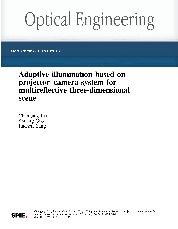摘要
We introduce a technique for illumination optimization based on a projector-camera system applied to a multireflective three-dimensional (3-D) scene. Simple mapping would fail if the scene is nonplane since they would translate to incoherent mapping between the projector and the camera. The correspondence between the pixels on the projector and camera in multireflective 3-D scene was indirectly established by surface orientation measurement. Once the correspondence was established, the local light was adapted by using the iteration in order to obtain the optimal illumination intensities at different surface orientations. User intervention for judging the desirable image is required in the iteration stage since there is no absolute reference for comparison to which the object must appear. According to the feedback from the camera, the projector is to compensate for surface reflectance for the most part by modulating the projection brightness at each pixel to be inversely proportional to the brightness of the pixel under uniform light. The time required for this adaptive illumination can be shortened to the inspection stage of 40 ms as long as the inspected object does not change in orientation or location. This proposed technique aims to enhance the illumination capabilities and presents a more unified system than existing methods.
- 出版日期2017-2
- 单位天津大学
